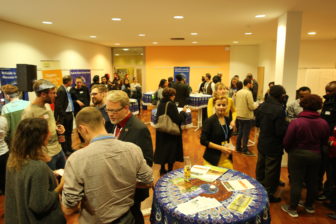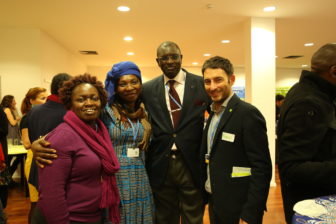Imagine this: You’re at a secluded space with 25,000 people from all over the world. This space has been created exclusively for the purpose of hosting an international meeting. Once you leave, this space will be dismantled and there will be no trace of its existence.
To enter this space, you need a special badge. To obtain this badge you need to follow a number of steps that include providing copious amounts of personal information and eventually, if you fulfill all the requirements, you’ll be granted a pass.
Once you arrive to this space, you have to follow strict security measures to enter, but once there, you’re provided with everything you may need: an arguably secure Internet connection, colorful stall bathrooms with signs that indicate the correct position to sit on the toilet, a water bottle that can be refilled at any of the water stations that have been set up, really expensive food with up to 20% of organic ingredients guaranteed and multiple outlets to plug in your phone or computer. You also find a computer center with printers, screens indicating the gazillion panels and side events happening simultaneously at the space, and plenty of sandwiches, canapés, coffee and even sometimes wine or cocktails—depending on the time of the day—given to you for free by event organizers with the only condition that you do attend their event.
There is a blue zone (here Bula zone, the most common way to greet in Fiji, the country that co-hosts this event) and a green zone (in this case the Bonn zone). People move in waves from the blue zone, where official negotiations take place to the green zone where side events and some high-level meetings happen.
In the middle of these two areas, which for practical and visual purposes I’ll call cyan, you can stand for hours watching thousands of people from all nationalities, languages, cultures and ethnicities moving back and forth, trying to get a meeting with their country delegation, finding the meeting space where the best side event connected to their area of work or interest is, and lobbying governments or high level delegations to buy their latest idea to either mitigate or adapt to the inevitable: a warming planet.
All of this at a sterilized space that doesn’t let the very cold air from outside be felt or street smells or sounds to permeate. A space filled with screens, talking computers and lights, and virtual reality displays that makes it look like a scene from Blade Runner—the original one.
All these people have gathered with one purpose: limit the rise of temperatures below 2°C. They are aware of the fact that changes in climate are taking the elevator, and solutions and actions are taking the stairs. Perhaps the lack of enforcement and mandatory systems in place to reduce greenhouse gas emissions is part of the reason why this is happening? Or could it be the lack of appropriate and sufficient investment and funding in projects devoted to regenerating the system instead of degenerating it by producing, consuming and extracting the old way?
Whatever the reason, the thousands of people in the green, blue and cyan zones are afraid. And fear, as we know, is a bad adviser, mainly because it opens the door to those who come with magical solutions, pseudoscience, and smoke and mirrors, those who are often the ones who created the problem in the first place.
At COP23, which was held in Bonn, Germany from Nov. 6 – 17, those smoke and mirrors were known as geoengineering. Geoengineering proposals were covered in detail in the newspaper offered at COP. A particularly interesting article caught my attention. The title: “Risky last-minute options.” It compared Plan B (geoengineering) to a course of chemotherapy with high risks. Some of the examples for this Plan B, as addressed in the article, are the use of mirrors (positioned in near-Earth space, these mirrors will reflect the rays of the sun back into space), global reforestation, chemical substances (mostly sulphur, distributed by aircrafts in the upper echelons of the atmosphere to cool the Earth by reflecting the sunlight), white house roofs and roads, and redirecting the CO2 from fossil power plants into the Earth’s crust so that over time it converts into rock.
A delegation sent by the United States, a country that has withdrawn from the Paris agreement but knows big business when it sees it, was the strongest advocate for this science fiction, Plan B type of solutions. It makes sense that the United States would seek geoengineering as a financial opportunity and a way to continue emitting even when they know it is nothing but a dangerous patch that doesn’t attack the root causes of the problem.
But there was even more. I turned the official newspaper pages and found articles talking about another solution. I walked by the green, cyan and blue zones and saw booths with information about it. I attended panels and people discussed it. I heard it in the hallways as well. People were talking about Beccs. Beccs, or Bioenergy with Carbon Capture Storage, seems like the less crazy of the science fiction strategies. Except that it comes with a very high cost. What it does is it captures carbon from the air by growing trees, burning those trees to generate energy, and burying the emissions using carbon capture and storage. For the whole scheme to work, trees have to be replanted to continue the cycle.
This technology and all of its potential profitability is sponsored by ______ (fill in the blanks with the name of your favorite extractive corporation).
What are the potential effects of Beccs? This “technology” would cover acres with monoculture plantations, ruining woodland biodiversity and its capacity to suck carbon. It has been estimated that for Beccs to generate the necessary amount of negative emissions to hit 1.5C, 5 million square kilometers of land would be needed.– It would imply waiting for years to have the replacement trees ready to be burned and, fundamentally, it would displace millions of farmers and indigenous populations from their lands that would now be used as tree farmlands for burning creating more poverty, forced migration and food insecurity. Nothing that we haven’t seen before.
Clearly, human beings have a hard time thinking long term. Long term isn’t sexy or profitable, and doesn’t result in political electoral benefits. We created this spaces where we could make ourselves feel a little bit better about what we’re doing for future generations and pat each other on the back before we headed home, before this bubble where we coexisted for two weeks disappears and things become less urgent, and the planet is no longer in the spotlight.
But if we continue this way, if we don’t change the root causes of the problem, then this story will end soon. Perhaps it’s time for us to start writing our own novel, one where the main characters are those who have for centuries been neglected and persecuted.
A story that tells the tales of the many people who are, every day, doing something to better our planet, from regenerating the soils to creating more efficient and sustainable means of transportation, from defending biodiversity at the cost of risking or sacrificing their own lives, to those who are investing their time, minds and money to come up with real, non-threatening, holistic solutions that can solve the problem.
This, my friends, is not science fiction. This is something that’s happening all over the world and is happening now. It’s time for us to record, write and propagate this story. A story with deep, rich roots that go deep into the ground. A story that also sequesters carbon.
Ercilia Sahores is political director for Organic Consumers Association – Mexico, and a representative of Regeneration International.



